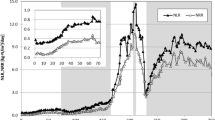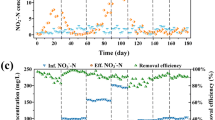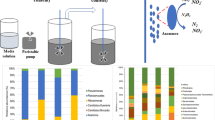Abstract
Anaerobic ammonium oxidation (anammox) has been implemented as a cost-effective nitrogen removal process in wastewater treatment. To apply the process to saline wastewater treatment at temperatures below 30 °C, the effectiveness of marine anammox bacteria has been demonstrated in a pilot-scale reactor. Nevertheless, mesophilic conditions, often found in underground brine containing high NH4+ concentrations, have yet to employ an anammox process. The objective of this study was to enrich anammox bacteria capable of removing nitrogen from underground brine possessing a salinity of 3% and at a temperature over 30 °C. To select a promising inoculum, biomass from a brine settling tank in a natural gas plant was subjected to quantifying transcripts of anammox 16S rRNA and hydrazine oxidoreductase (hzo) genes by quantitative reverse transcription polymerase chain reaction. A fixed-bed column anammox reactor was fed with the selected inoculum and operated feeding underground brine mixed with NaNO2 solution at a temperature of 38 °C. As a result, a nitrogen removal rate (NRR) of 1.42 kg-N/m3/day was obtained on day 167. An average NRR of 1.21 kg-N/m3/day and nitrogen removal efficiency of 88% were maintained for 50 days. Amplicon sequencing based on the 16S rRNA revealed that anammox bacteria which are phylogenetically close to Candidatus Kuenenia were successfully enriched in the reactor. These results indicate that nonmarine anammox bacteria can be active and predominant under both high-salinity and mesophilic conditions, making it a likely candidate for effective nitrogen removal from underground and waste brine.
Graphical abstract






Similar content being viewed by others

References
Ali M, Okabe S (2015) Anammox-based technologies for nitrogen removal: advances in process start-up and remaining issues. Chemosphere 141:144–153. https://doi.org/10.1016/j.chemosphere.2015.06.094
Awata T, Oshiki M, Kindaichi T, Ozaki N, Ohashi A, Okabe S (2013) Physiological characterization of an anaerobic ammonium-oxidizing bacterium belonging to the “Candidatus Scalindua” group. Appl Environ Microbiol 79(13):4145–4148. https://doi.org/10.1128/aem.00056-13
Bale NJ, Villanueva L, Fan H, Stal LJ, Hopmans EC, Schouten S, Damsté JSS (2014) Occurrence and activity of anammox bacteria in surface sediments of the southern North Sea. Microb Ecol 89:99–110. https://doi.org/10.1111/1574-6941.12338
Byrne N, Strous M, Crépeau V, Kartal B, Birrien JL, Schmid M, Lesongeur F, Schouten S, Jaeschke A, Jetten M, Prieur D, Godfroy A (2009) Presence and activity of anaerobic ammonium-oxidizing bacteria at deep-sea hydrothermal vents. ISME J 3:117–123. https://doi.org/10.1038/ismej.2008.72
Caporaso JG, Lauber CL, Walters WA, Berg-Lyons D, Huntley J, Fierer N, Owens SM, Betley J, Fraser L, Bauer M, Gormley N, Gilbert JA, Smith G, Knight R (2012) Ultra-high-throughput microbial community analysis on the Illumina HiSeq and MiSeq platforms. ISME J 6:1621–1624. https://doi.org/10.1038/ismej.2012.8
Chen H, Ma C, Ji YX, Ni WM, Jin RC (2014) Evaluation of the efficacy and regulation measures of the anammox process under salty conditions. Purif Technol 132:584–592. https://doi.org/10.1016/j.seppur.2014.06.012
Dalsgaard T, Thamdrup B (2002) Factors controlling anaerobic ammonium oxidation with nitrite in marine sediments. Appl Environ Microbiol 68:3802–3808. https://doi.org/10.1128/aem.68.8.3802-3808.2002
Egli K, Fanger U, Alvarez PJJ, Siegrist H, van der Meer JR, Zehnder AJB (2001) Enrichment and characterization of an anammox bacterium from a rotating biological contactor treating ammonium-rich leachate. Arch Microbiol 175:198–207. https://doi.org/10.1007/s002030100255
Humbert S, Tarnawski S, Fromin N, Mallet MP, Aragno M, Zopfi J (2010) Molecular detection of anammox bacteria in terrestrial ecosystems: distribution and diversity. ISME J 4:450–454. https://doi.org/10.1038/ismej.2009.125
Humbert S, Zopfi J, Tarnawski SE (2012) Abundance of anammox bacteria in different wetland soils. Environ Microbiol Rep 4:484–490. https://doi.org/10.1111/j.1758-2229.2012.00347.x
Kartal B, Koleva M, Arsov M, van der Star W, Jetten MSM, Strous M (2006) Adaptation of a freshwater anammox population to high salinity wastewater. J Biotechnol 126:546–553. https://doi.org/10.1016/j.jbiotec.2006.05.012
Kawagoshi Y, Nakamura Y, Kawashima H, Fujisaki K, Fujimoto A, Furukawa K (2009) Enrichment culture of marine anaerobic ammonium oxidation (anammox) bacteria from sediment of sea-based waste disposal site. J Biosci Bioeng 107:61–63. https://doi.org/10.1016/j.jbiosc.2008.10.003
Kawagoshi Y, Fujisaki K, Tomoshige Y, Yamashiro K, Wei Q (2012) Temperature effect on nitrogen removal performance and bacterial community in culture of marine anammox bacteria derived from sea-based waste disposal site. J Biosci Bioeng 113:515–520. https://doi.org/10.1016/j.jbiosc.2011.11.024
Khramenkov SV, Kozlov MN, Kevbrina MV, Dorofeev AG, Kazakova EA, Grachev VA, Kuznetsov BB, Polyakov DY, Nikolaev YA (2013) A novel bacterium carrying out anaerobic ammonium oxidation in a reactor for biological treatment of the filtrate of wastewater fermented sludge. Microbiology 82:628–636. https://doi.org/10.1134/S002626171305007x
Kindaichi T, Awata T, Tanabe K, Ozaki N, Ohashi A (2011) Enrichment using an up-flow column reactor and community structure of marine anammox bacteria from coastal sediment. Water Sci Technol 63:964–969. https://doi.org/10.1264/jsme2.me10158
Kuypers MMM, Sliekers AO, Lavik G, Schmid M, Jorgensen BB, Kuenen JG, Damste JSS, Strous M, Jetten MSM (2003) Anaerobic ammonium oxidation by anammox bacteria in the Black Sea. Nature 422:608–611. https://doi.org/10.1038/nature01472
Lackner S, Gilbert EM, Vlaeminck SE, Joss A, Horn H, van Loosdrecht MCM (2014) Full-scale partial nitritation/anammox experiences—an application survey. Water Res 55:292–303. https://doi.org/10.1016/j.watres.2014.02.032
Li H, Chen S, Mu BZ, Gu JD (2010) Molecular detection of anaerobic ammonium-oxidizing (anammox) bacteria in high-temperature petroleum reservoirs. Microb Ecol 60:771–783. https://doi.org/10.1007/s00248-010-9733-3
Li J, Qi P, Qiang Z, Dong H, Gao D, Wang D (2018) Is anammox a promising treatment process for nitrogen removal from nitrogen-rich saline wastewater? Bioresour Technol 270:722–731. https://doi.org/10.1016/j.biortech.2018.08.115
Lipsewers YA, Bale NJ, Hopmans EC, Schouten S, Damsté JSS, Villanueva L (2014) Seasonality and depth distribution of the abundance and activity of ammonia oxidizing microorganisms in marine coastal sediments (North Sea). Front Microbiol 5:472. https://doi.org/10.3389/fmicb.2014.00472
Liu C, Yamamoto T, Nishiyama T, Fujii T, Furukawa K (2009) Effect of salt concentration in anammox treatment using non-woven biomass carrier. J Biosci Bioeng 107:519–523. https://doi.org/10.1016/j.jbiosc.2009.01.020
Lotti T, Kleerebezem R, Hu Z, Kartal B, Jetten MSM, van Loosdrecht MCM (2014) Simultaneous partial nitritation and anammox at low temperature with granular sludge. Water Res 66:111–121. https://doi.org/10.1016/j.watres.2014.07.047
Ma C, Jin RC, Yang GF, Yu JJ, Xing BS, Zhang QQ (2012) Impacts of transient salinity shock loads on anammox process performance. Biores Technol 112:124–130. https://doi.org/10.1016/j.biortech.2012.02.122
Ondov BD, Bergman NH, Phillippy AM (2011) Interactive metagenomic visualization in a Web browser. BMC Bioinform 12:385. https://doi.org/10.1186/1471-2105-12-385
Oshiki M, Satoh H, Okabe S (2016) Ecology and physiology of anaerobic ammonium oxidizing bacteria. Environ Microbiol 18:2784–2796. https://doi.org/10.1111/1462-2920.13134
Park H, Rosenthal A, Ramalingam K, Fillos J, Chandran K (2010) Linking community profiles, gene expression and N-removal in anammox bioreactors treating municipal anaerobic digestion reject water. Environ Sci Technol 44:6110–6116. https://doi.org/10.1021/es1002956
Park G, Takekawa M, Soda S, Ike M, Furukawa K (2017) Temperature dependence of nitrogen removal activity by anammox bacteria enriched at low temperatures. J Biosci Bioeng 123:505–511. https://doi.org/10.1016/j.jbiosc.2016.11.009
Rysgaard S, Glud RN, Risgaard-Petersen N, Dalsgaard T (2004) Denitrification and anammox activity in Arctic marine sediments. Limnol Oceanogr 49:1493–1502. https://doi.org/10.4319/lo.2004.49.5.1493
Schmid MC, Hooper AB, Klotz MG, Woebken D, Lam P, Kuypers MMM (2008) Environmental detection of octahaem cytochrome c hydroxylamine/hydrazine oxidoreductase genes of aerobic and anaerobic ammonium-oxidizing bacteria. Environ Microbiol 10:3140–3149. https://doi.org/10.1111/j.1462-2920.2008.01732.x
Shinohara T, Qiao S, Yamamoto T, Nishiyama T, Fujii T, Kaiho T, Bhatti Z, Furukawa K (2009) Partial nitritation treatment of underground brine waste with high ammonium and salt content. Journal of Bioscience and Bioengineering 108 (4):330–335
Stewart FJ, Ulloa O, DeLong EF (2012) Microbial metatranscriptomics in a permanent marine oxygen minimum zone. Environ Microbiol 14:23–40. https://doi.org/10.1111/j.1462-2920.2010.02400.x
Strous M, Heijnen JJ, Kuenen JG, Jetten MSM (1998) The sequencing batch reactor as a powerful tool for the study of slowly growing anaerobic ammonium-oxidizing microorganisms. Appl Microbiol Biotechnol 50:589–596. https://doi.org/10.1007/s002530051340
Terada A, Lackner S, Kristensen K, Smets BF (2010) Inoculum effects on community composition and nitritation performance of autotrophic nitrifying biofilm reactors with counter-diffusion geometry. Environ Microbiol 12(10):2858–2872. https://doi.org/10.1111/j.1462-2920.2010.02267.x
Terada A, Zhou S, Hosomi M (2011) Presence and detection of anaerobic ammonium-oxidizing (anammox) bacteria and appraisal of anammox process for high-strength nitrogenous wastewater treatment: a review. Clean Technnol Environ Policy 13:759–781. https://doi.org/10.1007/s10098-011-0355-3
Tsushima I, Ogasawara Y, Kindaichi T, Satoh H, Okabe S (2007) Development of high-rate anaerobic ammonium-oxidizing (anammox) biofilm reactors. Water Res 41:1623–1634. https://doi.org/10.1016/j.watres.2007.01.050
van de Vossenberg J, Rattray JE, Geerts W, Kartal B, van Niftrik L, van Donselaar EG, Damste JSS, Strous M, Jetten MSM (2008) Enrichment and characterization of marine anammox bacteria associated with global nitrogen gas production. Environ Microbiol 10:3120–3129. https://doi.org/10.1111/j.1462-2920.2008.01643.x
Wang S, Peng Y, Ma B, Wang S, Zhu G (2015) Anaerobic ammonium oxidation in traditional municipal wastewater treatment plants with low-strength ammonium loading: widespread but overlooked. Water Res 84:66–75. https://doi.org/10.1016/j.watres.2015.07.005
Wei Q, Huang X, Tomoshige Y, Hong N, Hama T, Kawagoshi Y (2015) Comparative study on HRT and nitrogen concentration effects on enhancement of nitrogen removal by marine anammox bacteria (MAB). Water Environ Technol 13:119–130. https://doi.org/10.2965/jwet.2015.119
Yokota N, Watanabe Y, Tokutomi T, Kiyokawa T, Hori T, Ikeda D, Song K, Hosomi M, Terada A (2018) High-rate nitrogen removal from waste brine by marine anammox bacteria in a pilot-scale UASB reactor. Appl Microbiol Biotechnol 102:1501–1512. https://doi.org/10.1007/s00253-017-8663-0
Acknowledgements
This study was partially funded by the Japanese Society for the Promotion of Science (Grant 17H01893). The authors also thank Professor Barth F. Smets (Technical University of Denmark) and Emeritus Professor Kenji Furukawa (Kumamoto University) for valuable comments.
Author information
Authors and Affiliations
Corresponding author
Additional information
Publisher's Note
Springer Nature remains neutral with regard to jurisdictional claims in published maps and institutional affiliations.
Electronic supplementary material
Below is the link to the electronic supplementary material.
Rights and permissions
About this article
Cite this article
Yokota, N., Mineshima, R., Yamaguchi, H. et al. Startup, performance, and microbial communities of an anammox reactor inoculated with indigenous sludge for the treatment of high-salinity and mesophilic underground brine. Clean Techn Environ Policy 21, 1001–1011 (2019). https://doi.org/10.1007/s10098-019-01688-y
Received:
Accepted:
Published:
Issue Date:
DOI: https://doi.org/10.1007/s10098-019-01688-y



